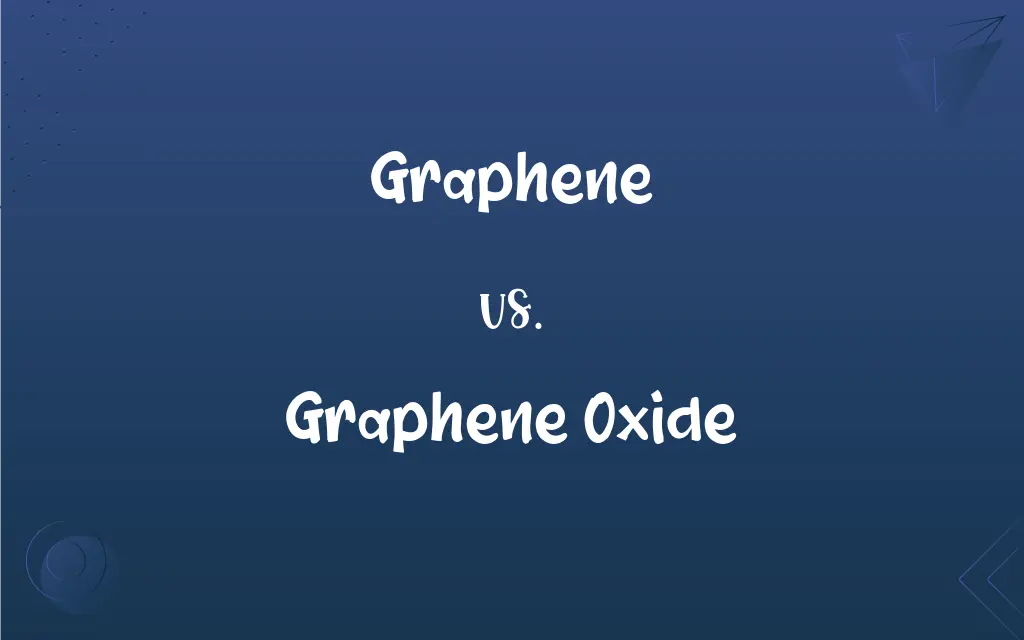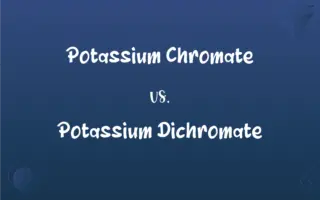Graphene vs. Graphene Oxide: What's the Difference?
Edited by Aimie Carlson || By Janet White || Published on December 25, 2023
Graphene is a single layer of carbon atoms in a hexagonal lattice; Graphene Oxide is graphene with oxygen and other functional groups attached.

Key Differences
Graphene is a single layer of carbon atoms arranged in a two-dimensional hexagonal lattice, known for its exceptional strength, conductivity, and thinness. Graphene Oxide (GO) is a derivative of graphene, featuring various oxygen-containing groups, which alters its properties, making it less conductive but more soluble in water.
Graphene is highly conductive, both electrically and thermally, and is one of the strongest materials known. It is used in a variety of applications, from electronics to composites. Graphene Oxide, on the other hand, has reduced electrical conductivity due to the disruption of its sp2 bonding networks by oxygen groups, but its increased solubility makes it useful in fields like material science and biomedical applications.
Graphene is hydrophobic, meaning it repels water, which limits its use in certain applications. Graphene Oxide is hydrophilic, meaning it can interact with water, which expands its usability in aqueous solutions and for certain chemical processes.
Graphene can be produced through methods like mechanical exfoliation or chemical vapor deposition, which yield a pure form of graphene. Graphene Oxide is typically produced by oxidizing graphite, a process that introduces oxygen-containing groups to the graphene structure.
Graphene has potential applications in high-speed electronics, sensors, and advanced composites due to its unique properties. Graphene Oxide is used in areas like drug delivery, water purification, and as a precursor for producing other graphene-based materials.
ADVERTISEMENT
Comparison Chart
Composition
Single layer of carbon atoms.
Graphene with oxygen and other functional groups.
Conductivity
Highly conductive electrically and thermally.
Reduced electrical conductivity.
Water Interaction
Hydrophobic (repels water).
Hydrophilic (interacts with water).
Production Method
Mechanical exfoliation, chemical vapor deposition.
Oxidizing graphite.
Applications
Electronics, sensors, composites.
Drug delivery, water purification, material science.
ADVERTISEMENT
Graphene and Graphene Oxide Definitions
Graphene
Graphene is known for its excellent electrical and thermal conductivity.
They used graphene in the circuit for its superior conductivity.
Graphene Oxide
Graphene Oxide has reduced electrical conductivity compared to graphene.
The graphene oxide film was less conductive but perfect for the application.
Graphene
Graphene is one of the strongest materials known, despite its thinness.
The graphene composite material was both lightweight and exceptionally strong.
Graphene Oxide
Graphene Oxide is typically produced by oxidizing graphite.
The lab produced graphene oxide by treating graphite with strong oxidizers.
Graphene
Graphene is hydrophobic and has potential in advanced electronics.
The graphene coating made the device water-resistant.
Graphene Oxide
Graphene Oxide is hydrophilic, unlike graphene.
Graphene oxide's water-friendly nature was useful in creating new filtration membranes.
Graphene
Graphene is a single layer of carbon atoms in a hexagonal lattice.
The graphene sheet was remarkably strong yet incredibly thin.
Graphene Oxide
Graphene Oxide is graphene with oxygen and other functional groups.
Graphene oxide's solubility in water makes it ideal for certain chemical processes.
Graphene
Graphene is produced from graphite through various methods like chemical vapor deposition.
They created high-quality graphene using the chemical vapor deposition technique.
Graphene Oxide
Graphene Oxide is used in drug delivery and water purification.
They used graphene oxide in developing a new drug delivery system.
Graphene
A monolayer of carbon atoms having a hexagonal lattice structure and constituting a basic structural element of graphite, fullerenes, and carbon nanotubes.
Graphene
(organic chemistry) Any polycyclic aromatic hydrocarbon having the structure of part of a layer of graphite.
Graphene
(inorganic chemistry) An arbitrarily large-scale, one-atom-thick layer of graphite, an allotrope of carbon, that has remarkable electric characteristics.
FAQs
Can graphene oxide conduct electricity?
Graphene oxide has reduced electrical conductivity compared to graphene due to the presence of oxygen groups.
Is graphene naturally occurring?
Graphene is not found naturally; it's produced from graphite, a naturally occurring form of carbon.
What is graphene?
Graphene is a two-dimensional layer of carbon atoms arranged in a hexagonal lattice.
How is graphene different from graphite?
Graphene is a single atomic layer of carbon, whereas graphite is composed of multiple layers of graphene stacked together.
What are potential applications of graphene?
Potential applications of graphene include high-speed electronics, advanced composites, and sensors.
What is graphene oxide used for?
Graphene oxide is used in water purification, drug delivery, and as a precursor for other graphene materials.
How is graphene used in electronics?
Graphene is used in electronics for its high electrical conductivity and thin, flexible nature.
What are the unique properties of graphene?
Graphene's unique properties include high strength, conductivity, and flexibility.
Is graphene oxide toxic?
The toxicity of graphene oxide can depend on its form and how it's used; research in this area is ongoing.
Can graphene be used in batteries?
Yes, graphene can be used in batteries to improve capacity and charge rates.
How is graphene oxide made?
Graphene oxide is made by treating graphite with strong oxidizers, introducing oxygen-containing groups.
Is graphene oxide soluble in water?
Yes, graphene oxide is hydrophilic and more soluble in water than graphene.
Can graphene oxide be used in medical applications?
Yes, graphene oxide's properties make it suitable for applications like drug delivery systems.
What are the challenges in working with graphene?
Challenges with graphene include its production cost and integrating it into existing materials and technologies.
Is graphene more conductive than copper?
Yes, graphene is more electrically conductive than copper.
Why is graphene oxide important in research?
Graphene oxide is important for its versatility in applications like material science and biomedicine.
How does graphene oxide help in water purification?
Graphene oxide helps in water purification by filtering out contaminants due to its fine, porous structure and chemical properties.
How does the hydrophilicity of graphene oxide benefit its applications?
The hydrophilicity of graphene oxide makes it useful in applications involving water, like filtration and purification.
What makes graphene oxide different from other carbon materials?
Graphene oxide's unique combination of graphene structure with oxygen functional groups sets it apart from other carbon materials.
Is graphene flexible?
Yes, graphene is extremely flexible and can be bent without breaking.
About Author
Written by
Janet WhiteJanet White has been an esteemed writer and blogger for Difference Wiki. Holding a Master's degree in Science and Medical Journalism from the prestigious Boston University, she has consistently demonstrated her expertise and passion for her field. When she's not immersed in her work, Janet relishes her time exercising, delving into a good book, and cherishing moments with friends and family.
Edited by
Aimie CarlsonAimie Carlson, holding a master's degree in English literature, is a fervent English language enthusiast. She lends her writing talents to Difference Wiki, a prominent website that specializes in comparisons, offering readers insightful analyses that both captivate and inform.

































































